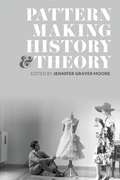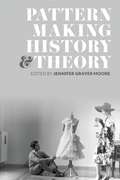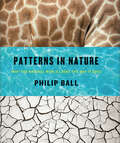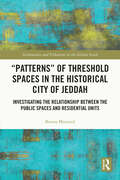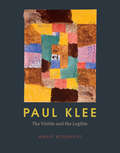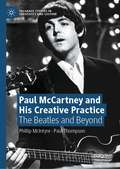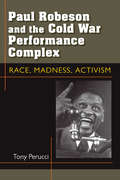- Table View
- List View
Patternmaking for Dress Design: 9 Iconic Styles from Empire to Cheongsam
by Pamela VanderlindePatternmaking for Dress Design covers patternmaking techniques for 9 iconic dress designs, focusing not only on the concepts needed to draft patterns, but also uniquely exploring the history of each garment design to reveal what lies behind their enduring appeal today. Each chapter provides easy-to-follow patterns for the sheath, empire, shift, trapeze, wrap, strapless, shirtwaist, cheongsam and coatdress.
Patternmaking for Dress Design: 9 Iconic Styles from Empire to Cheongsam
by Pamela VanderlindePatternmaking for Dress Design covers patternmaking techniques for 9 iconic dress designs, focusing not only on the concepts needed to draft patterns, but also uniquely exploring the history of each garment design to reveal what lies behind their enduring appeal today. Each chapter provides easy-to-follow patterns for the sheath, empire, shift, trapeze, wrap, strapless, shirtwaist, cheongsam and coatdress.
Patternmaking for Jacket and Coat Design (Required Reading Range)
by Pamela VanderlindeJacket design gives students and designers alike trouble, both technically and creatively; the technicality of their design and existing texts on the subject often leave novices and budding designers puzzled.Patternmaking for Jacket and Coat Design covers patternmaking techniques for seven iconic jacket and coat designs, focusing not only on the concepts needed to draft patterns, but also uniquely exploring the history of each garment design to reveal what lies behind their enduring appeal today. Each chapter provides easy-to-follow patterns for the blazer, tuxedo, military, motorcycle and Mao jackets, as well as the balmacaan and frock coats.Patternmaking for Jacket and Coat Design is an accessible, no-fuss, and visually stimulating manual for patterning iconic jackets and coats, providing a completely invaluable resource for both designers and amateur patternmakers.
Patternmaking for Jacket and Coat Design (Required Reading Range Ser.)
by Pamela VanderlindeJacket design gives students and designers alike trouble, both technically and creatively; the technicality of their design and existing texts on the subject often leave novices and budding designers puzzled.Patternmaking for Jacket and Coat Design covers patternmaking techniques for seven iconic jacket and coat designs, focusing not only on the concepts needed to draft patterns, but also uniquely exploring the history of each garment design to reveal what lies behind their enduring appeal today. Each chapter provides easy-to-follow patterns for the blazer, tuxedo, military, motorcycle and Mao jackets, as well as the balmacaan and frock coats.Patternmaking for Jacket and Coat Design is an accessible, no-fuss, and visually stimulating manual for patterning iconic jackets and coats, providing a completely invaluable resource for both designers and amateur patternmakers.
Patternmaking History and Theory
by Edited by Jennifer Grayer MooreFashion design is increasingly gaining attention as an important form of cultural expression. However, scholarship has largely focused on specific designers and their finished products. This collection reveals the crucial foundational art and craft of patternmaking design, with essays that explore the practice in specific historical and cultural contexts. Probing the theoretical underpinnings that inform patternmaking, Patternmaking History and Theory interrogates topics that span cultures and time periods, ranging from high fashion to home sewing. Taking the reader from women's making and mending for victory during World War Two, to Jamaican dress history and today's complex 3D pattern cutting software, the book examines the creative aspect of a culturally rich skill. Beautifully illustrated and rooted in original research, Patternmaking History and Theory brings together a group of leading international scholars to provide a range of perspectives on a key but often overlooked aspect of design.
Patternmaking History and Theory
Fashion design is increasingly gaining attention as an important form of cultural expression. However, scholarship has largely focused on specific designers and their finished products. This collection reveals the crucial foundational art and craft of patternmaking design, with essays that explore the practice in specific historical and cultural contexts. Probing the theoretical underpinnings that inform patternmaking, Patternmaking History and Theory interrogates topics that span cultures and time periods, ranging from high fashion to home sewing. Taking the reader from women's making and mending for victory during World War Two, to Jamaican dress history and today's complex 3D pattern cutting software, the book examines the creative aspect of a culturally rich skill. Beautifully illustrated and rooted in original research, Patternmaking History and Theory brings together a group of leading international scholars to provide a range of perspectives on a key but often overlooked aspect of design.
Patternmaking with Stretch Knit Fabrics: - with STUDIO
by Julie ColeWith hundreds of step-by-step illustrated instructions and a user-friendly, stay-flat format, Patternmaking with Stretch Knit Fabrics provides emerging fashion designers with comprehensive information on how to draft patterns for popular cut-and-sew stretch knit fabrics such as jersey and knits with spandex. After covering the basics of knits and techniques for gauging stretch capacity, Julie Cole introduces a unique, simplified approach to drafting slopers using hip and top foundations. She then provides information on converting, drafting, grading, and reducing patterns for proper fit in four categories of stretch. The book proceeds to drafting slopers and patterns for tops, dresses, jackets, sweaters, cardigans, skirts, pants, lingerie, swimwear, and activewear.Patternmaking with Stretch Knit Fabrics is ideal for students with basic or intermediate design, patternmaking, and sewing skills for any course in which students design and draft patterns for knits; or courses that incorporate both knits and woven fabrics.Features- Accurate and simplified system for patternmaking with stretch knit fabrics with easier to follow approach than other books-Each chapter includes - Key terms - Highly-illustrated step-by-step instructions - Three types of boxes: "Important", "Pattern Tip", and "Stitching Tip"- End of chapter features "Knit It Together" checklist, "Stop! What Do I Do If..." troubleshooting tips, and "Self Critique" review- More than 900 technical drawings with color accents and 100 photographs of sewn samples on the dress formPatternmaking with Stretch Knit Fabric STUDIO- Study smarter with self-quizzes featuring scored results and personalized study tips- Review concepts with flashcards of terms and definitions - Access downloadable files for half-size top and hip foundations, and slopers found in the bookTeaching Resources- Instructor's Guide and Test Bank includes sample syllabi, suggested projects, test questions, and evaluation guidesPLEASE NOTE: Purchasing or renting this ISBN does not include access to the STUDIO resources that accompany this text. To receive free access to the STUDIO content with new copies of this book, please refer to the book + STUDIO access card bundle ISBN 9781501318245.
Patterns: Design and Composition
by M.A Hann I.S. MoxonIn Patterns: Design and Composition, M. A. Hann and I. S. Moxon present guidelines for the original design and composition of regular patterns alongside an understanding of the inherent structures of these patterns. Starting with the compositional elements, Hann and Moxon take the reader through patterns in the environment, early forms of patterns and aspects of classification based on circles, squares, triangles and symmetry. With 250 images sourced from past examples as well as student work, this essential read for design students and researchers demonstrates how simplicity begets complexity in the design and composition of regular patterns.
Patterns: Design and Composition (Textile Progress Ser. #Vol. 22, No. 1)
by M.A Hann I.S. MoxonIn Patterns: Design and Composition, M. A. Hann and I. S. Moxon present guidelines for the original design and composition of regular patterns alongside an understanding of the inherent structures of these patterns. Starting with the compositional elements, Hann and Moxon take the reader through patterns in the environment, early forms of patterns and aspects of classification based on circles, squares, triangles and symmetry. With 250 images sourced from past examples as well as student work, this essential read for design students and researchers demonstrates how simplicity begets complexity in the design and composition of regular patterns.
Patterns in Nature: Why the Natural World Looks the Way It Does
by Philip BallThough at first glance the natural world may appear overwhelming in its diversity and complexity, there are regularities running through it, from the hexagons of a honeycomb to the spirals of a seashell and the branching veins of a leaf. Revealing the order at the foundation of the seemingly chaotic natural world, Patterns in Nature explores not only the math and science but also the beauty and artistry behind nature’s awe-inspiring designs. Unlike the patterns we create in technology, architecture, and art, natural patterns are formed spontaneously from the forces that act in the physical world. Very often the same types of pattern and form – spirals, stripes, branches, and fractals, say—recur in places that seem to have nothing in common, as when the markings of a zebra mimic the ripples in windblown sand. That’s because, as Patterns in Nature shows, at the most basic level these patterns can often be described using the same mathematical and physical principles: there is a surprising underlying unity in the kaleidoscope of the natural world. Richly illustrated with 250 color photographs and anchored by accessible and insightful chapters by esteemed science writer Philip Ball, Patterns in Nature reveals the organization at work in vast and ancient forests, powerful rivers, massing clouds, and coastlines carved out by the sea. By exploring similarities such as those between a snail shell and the swirling stars of a galaxy, or the branches of a tree and those of a river network, this spectacular visual tour conveys the wonder, beauty, and richness of natural pattern formation.
Patterns in Nature: Why the Natural World Looks the Way It Does
by Philip BallThough at first glance the natural world may appear overwhelming in its diversity and complexity, there are regularities running through it, from the hexagons of a honeycomb to the spirals of a seashell and the branching veins of a leaf. Revealing the order at the foundation of the seemingly chaotic natural world, Patterns in Nature explores not only the math and science but also the beauty and artistry behind nature’s awe-inspiring designs. Unlike the patterns we create in technology, architecture, and art, natural patterns are formed spontaneously from the forces that act in the physical world. Very often the same types of pattern and form – spirals, stripes, branches, and fractals, say—recur in places that seem to have nothing in common, as when the markings of a zebra mimic the ripples in windblown sand. That’s because, as Patterns in Nature shows, at the most basic level these patterns can often be described using the same mathematical and physical principles: there is a surprising underlying unity in the kaleidoscope of the natural world. Richly illustrated with 250 color photographs and anchored by accessible and insightful chapters by esteemed science writer Philip Ball, Patterns in Nature reveals the organization at work in vast and ancient forests, powerful rivers, massing clouds, and coastlines carved out by the sea. By exploring similarities such as those between a snail shell and the swirling stars of a galaxy, or the branches of a tree and those of a river network, this spectacular visual tour conveys the wonder, beauty, and richness of natural pattern formation.
Patterns in Nature: Why the Natural World Looks the Way It Does
by Philip BallThough at first glance the natural world may appear overwhelming in its diversity and complexity, there are regularities running through it, from the hexagons of a honeycomb to the spirals of a seashell and the branching veins of a leaf. Revealing the order at the foundation of the seemingly chaotic natural world, Patterns in Nature explores not only the math and science but also the beauty and artistry behind nature’s awe-inspiring designs. Unlike the patterns we create in technology, architecture, and art, natural patterns are formed spontaneously from the forces that act in the physical world. Very often the same types of pattern and form – spirals, stripes, branches, and fractals, say—recur in places that seem to have nothing in common, as when the markings of a zebra mimic the ripples in windblown sand. That’s because, as Patterns in Nature shows, at the most basic level these patterns can often be described using the same mathematical and physical principles: there is a surprising underlying unity in the kaleidoscope of the natural world. Richly illustrated with 250 color photographs and anchored by accessible and insightful chapters by esteemed science writer Philip Ball, Patterns in Nature reveals the organization at work in vast and ancient forests, powerful rivers, massing clouds, and coastlines carved out by the sea. By exploring similarities such as those between a snail shell and the swirling stars of a galaxy, or the branches of a tree and those of a river network, this spectacular visual tour conveys the wonder, beauty, and richness of natural pattern formation.
Patterns in Nature: Why the Natural World Looks the Way It Does
by Philip BallThough at first glance the natural world may appear overwhelming in its diversity and complexity, there are regularities running through it, from the hexagons of a honeycomb to the spirals of a seashell and the branching veins of a leaf. Revealing the order at the foundation of the seemingly chaotic natural world, Patterns in Nature explores not only the math and science but also the beauty and artistry behind nature’s awe-inspiring designs. Unlike the patterns we create in technology, architecture, and art, natural patterns are formed spontaneously from the forces that act in the physical world. Very often the same types of pattern and form – spirals, stripes, branches, and fractals, say—recur in places that seem to have nothing in common, as when the markings of a zebra mimic the ripples in windblown sand. That’s because, as Patterns in Nature shows, at the most basic level these patterns can often be described using the same mathematical and physical principles: there is a surprising underlying unity in the kaleidoscope of the natural world. Richly illustrated with 250 color photographs and anchored by accessible and insightful chapters by esteemed science writer Philip Ball, Patterns in Nature reveals the organization at work in vast and ancient forests, powerful rivers, massing clouds, and coastlines carved out by the sea. By exploring similarities such as those between a snail shell and the swirling stars of a galaxy, or the branches of a tree and those of a river network, this spectacular visual tour conveys the wonder, beauty, and richness of natural pattern formation.
“Patterns” of Threshold Spaces in the Historical City of Jeddah: Investigating the Relationship Between the Public Spaces and Residential Units (Architecture and Urbanism in the Global South)
by Basma Massoud“Patterns” of Threshold Spaces in the Historical City of Jeddah explores the meaning of threshold spaces and investigates the relationship between the public spaces and residential units in the historical city of Jeddah, Saudi Arabia, while at the same time revisiting Christopher Alexander’s theory in his canonical 1977 book, A Pattern Language. This book questions and analyses “patterns” relating to the cultural, social, and environmental particularities of Jeddah, with special attention paid to the effect of gender segregation in the city’s urban configuration. It discusses the extension that has been undertaken through testing a concept from the urban design theory of the West (the United States and Canada) and applying it to an Islamic city to find patterns in four different scales, which form the basis of the investigation (body, building, street, and city). Empirical methods have been used in the context of historical Jeddah, through which patterns are investigated using different approaches for the different scales. The book aims to explore the meaning of threshold spaces in old Jeddah. Furthermore, it shows that there are eighteen patterns of threshold spaces in the old town: patterns that are solely related to this specific case study, as well as modified patterns to the ones explored by Christopher Alexander. This book shall allow not only a better understanding of the relationship between housing and the historical city but also an exploration of the role of the threshold space in shaping the old city of Jeddah. It will be of interest to researchers, students of architecture, urban planning and anthropology studies, and people involved in cultural heritage, both academics and practitioners.
“Patterns” of Threshold Spaces in the Historical City of Jeddah: Investigating the Relationship Between the Public Spaces and Residential Units (Architecture and Urbanism in the Global South)
by Basma Massoud“Patterns” of Threshold Spaces in the Historical City of Jeddah explores the meaning of threshold spaces and investigates the relationship between the public spaces and residential units in the historical city of Jeddah, Saudi Arabia, while at the same time revisiting Christopher Alexander’s theory in his canonical 1977 book, A Pattern Language. This book questions and analyses “patterns” relating to the cultural, social, and environmental particularities of Jeddah, with special attention paid to the effect of gender segregation in the city’s urban configuration. It discusses the extension that has been undertaken through testing a concept from the urban design theory of the West (the United States and Canada) and applying it to an Islamic city to find patterns in four different scales, which form the basis of the investigation (body, building, street, and city). Empirical methods have been used in the context of historical Jeddah, through which patterns are investigated using different approaches for the different scales. The book aims to explore the meaning of threshold spaces in old Jeddah. Furthermore, it shows that there are eighteen patterns of threshold spaces in the old town: patterns that are solely related to this specific case study, as well as modified patterns to the ones explored by Christopher Alexander. This book shall allow not only a better understanding of the relationship between housing and the historical city but also an exploration of the role of the threshold space in shaping the old city of Jeddah. It will be of interest to researchers, students of architecture, urban planning and anthropology studies, and people involved in cultural heritage, both academics and practitioners.
Patty Lyons' Knitting Bag of Tricks: Over 70 sanity saving hacks for better knitting
by Patty LyonsDo you wish your knitting was better and that you had an expert knitter by your side to help you when it goes wrong? Then this is the book for you. Patty Lyons is an expert in all things knitting related. She will help you solve all of your knitting problems—from edges that won’t behave to adjusting your yarn tension—with the 70+ hacks in Patty Lyons’ Knitting Bag of Tricks. Featuring dozens of brand new how-tos and the most popular tricks from author Patty Lyons’ beloved advice columns, this handy guide goes far beyond your typical knitting tips. Knitters of all levels will discover both why and how various techniques work, and improve both the look of their knitting and their command of stitches. It’s sure to take any knitter’s skills up to the next level. With more than 30K followers on social media and name-checks by everyone from the Wall Street Journal to popular television show, Late Night with Seth Meyers, Patty is a well-known name in the knitting community. This isn’t like other ‘how to knit’ books with basic information about casting on and how to form stitches (although there is a handy how-to reference section at the back for when you need a refresher), this is a book about the ‘why’ of knitting. Not about ‘why we knit’ but about ‘why we knit the way we do’. By digging deeper into the ‘why’ Patty doesn’t just fix your knitting problems she helps you to truly understand why the yarn/stitches/needles/tension are acting in a certain way and how to fix any issues. She starts by looking at the basics and explores the anatomy of a stitch, examining how this affects the look, feel and shape of the finished knitted fabrics and how different knitting techniques affect the finished outcome. Patty examines the problems caused by common mistakes that many knitters make without even noticing before diving into more complex knitting issues and how to trouble shoot them. All of Patty’s techniques and tips are illustrated with detailed step-by-step artworks for absolute clarity. And, as you’d expect from a Patty Lyons book, there is a healthy scattering of humor and irreverence throughout – you might take knitting seriously but you don’t have to be serious while knitting!
Paul Cézanne (Great Artists)
by Jane BinghamIn the words of Matisse and Picasso, Paul Cézanne was the 'father of us all', his approach to color and perspective paving the way for later modernist art movements such as Cubism and Expressionism, as he moved beyond the figurative tradition and towards abstraction. This book charts Cézanne's journey as an artist, his involvement with the Impressionist movement and his importance as a leading Post-Impressionist. It explores the places where he lived and worked, his personal life and friendships, and the artistic influences that helped to shape his remarkable vision of the world. This biographical detail is set alongside a selection of his brilliant paintings, allowing you to trace the evolution of his artwork. ABOUT THE SERIES: The Great Artists series by Arcturus Publishing introduces some of the most significant artists of the past 150 years, looking at their lives, techniques and inspirations, as well as presenting a selection of their best work.
Paul Cézanne (Great Artists of the World #1)
by Alix WoodGreat Artists introduces young readers to some of the world's great artists. The books feature easy-to-read text and some of the most famous examples of each artist's work, as well as photographs of places and people of importance.
Paul Delaroche: Painting and Popular Spectacle
by Patricia SmythPaul Delaroche: Painting and Popular Spectacle explores the connections between painting and an emergent popular visual culture in the early nineteenth century, which included new forms of optical entertainment such as Panoramas and Dioramas and innovation in fields such as illustration, art reproduction, and stage decor. Delaroche’s paintings caused a sensation at the Paris Salon, with critics comparing the emotional response they elicited to that of popular melodrama. Yet his appeal to a certain type of spectator lay behind the increasingly hostile criticism to which his works were subjected, and has in our own time led to his uncertain status in the art historical canon. This book focuses on Delaroche’s popularity with a newly expanded audience. Lacking in specialist knowledge, but nevertheless keen to engage with and deeply affected by art, the behaviour of this new public prompted lively discussions about who has the right to judge art and on whatgrounds.Working across disciplinary boundaries, this book proposes a new reading both of Delaroche and of the connections between the arts in this period. The artist emerges as a figure at the cutting edge of an emergent trans-medial popular visual culture in which we see the formation of modern spectatorship.
Paul Klee: The Visible and the Legible
by Annie BourneufThe fact that Paul Klee (1879–1940) consistently intertwined the visual and the verbal in his art has long fascinated commentators from Walter Benjamin to Michel Foucault. However, the questions it prompts have never been satisfactorily answered—until now. In Paul Klee, Annie Bourneuf offers the first full account of the interplay between the visible and the legible in Klee’s works from the 1910s and 1920s. Bourneuf argues that Klee joined these elements to invite a manner of viewing that would unfold in time, a process analogous to reading. From his elaborate titles to the small scale he favored to his metaphoric play with materials, Klee created forms that hover between the pictorial and the written. Through his unique approach, he subverted forms of modernist painting that were generally seen to threaten slow, contemplative viewing. Tracing the fraught relations among seeing, reading, and imagining in the early twentieth century, Bourneuf shows how Klee reconceptualized abstraction at a key moment in its development.
Paul Klee: The Visible and the Legible
by Annie BourneufThe fact that Paul Klee (1879–1940) consistently intertwined the visual and the verbal in his art has long fascinated commentators from Walter Benjamin to Michel Foucault. However, the questions it prompts have never been satisfactorily answered—until now. In Paul Klee, Annie Bourneuf offers the first full account of the interplay between the visible and the legible in Klee’s works from the 1910s and 1920s. Bourneuf argues that Klee joined these elements to invite a manner of viewing that would unfold in time, a process analogous to reading. From his elaborate titles to the small scale he favored to his metaphoric play with materials, Klee created forms that hover between the pictorial and the written. Through his unique approach, he subverted forms of modernist painting that were generally seen to threaten slow, contemplative viewing. Tracing the fraught relations among seeing, reading, and imagining in the early twentieth century, Bourneuf shows how Klee reconceptualized abstraction at a key moment in its development.
Paul Klee: The Visible and the Legible
by Annie BourneufThe fact that Paul Klee (1879–1940) consistently intertwined the visual and the verbal in his art has long fascinated commentators from Walter Benjamin to Michel Foucault. However, the questions it prompts have never been satisfactorily answered—until now. In Paul Klee, Annie Bourneuf offers the first full account of the interplay between the visible and the legible in Klee’s works from the 1910s and 1920s. Bourneuf argues that Klee joined these elements to invite a manner of viewing that would unfold in time, a process analogous to reading. From his elaborate titles to the small scale he favored to his metaphoric play with materials, Klee created forms that hover between the pictorial and the written. Through his unique approach, he subverted forms of modernist painting that were generally seen to threaten slow, contemplative viewing. Tracing the fraught relations among seeing, reading, and imagining in the early twentieth century, Bourneuf shows how Klee reconceptualized abstraction at a key moment in its development.
Paul Klee: The Visible and the Legible
by Annie BourneufThe fact that Paul Klee (1879–1940) consistently intertwined the visual and the verbal in his art has long fascinated commentators from Walter Benjamin to Michel Foucault. However, the questions it prompts have never been satisfactorily answered—until now. In Paul Klee, Annie Bourneuf offers the first full account of the interplay between the visible and the legible in Klee’s works from the 1910s and 1920s. Bourneuf argues that Klee joined these elements to invite a manner of viewing that would unfold in time, a process analogous to reading. From his elaborate titles to the small scale he favored to his metaphoric play with materials, Klee created forms that hover between the pictorial and the written. Through his unique approach, he subverted forms of modernist painting that were generally seen to threaten slow, contemplative viewing. Tracing the fraught relations among seeing, reading, and imagining in the early twentieth century, Bourneuf shows how Klee reconceptualized abstraction at a key moment in its development.
Paul McCartney and His Creative Practice: The Beatles and Beyond (Palgrave Studies in Creativity and Culture)
by Phillip McIntyre Paul ThompsonThis book provides fresh insight into the creative practice developed by Paul McCartney over his extended career as a songwriter, record producer and performing musician. It frames its examination of McCartney’s work through the lens of the systems model of creativity developed by Mihaly Csikszentmihalyi and combines this with the research work of Pierre Bourdieu. This systems approach is built around the basic structures of idiosyncratic agents, like McCartney himself, and the choices he has made as a creative individual. It also locates his work within social fields and cultural domains, all crucial aspects of the creative system that McCartney continues to be immersed in. Using this tripartite system, the book includes analysis of McCartney’s creative collaborations with musicians, producers, artists and filmmakers and provides a critical analysis of the Romantic myth which forms a central tenet of popular music. This engaging work will have interdisciplinary appeal to students and scholars of the psychology of creativity, popular music, sociology and cultural studies.
Paul Robeson and the Cold War Performance Complex: Race, Madness, Activism (Theater: Theory/Text/Performance)
by Tony PerucciActor and singer Paul Robeson's performances in Othello, Show Boat, and The Emperor Jones made him famous, but his midcentury appearances in support of causes ranging from labor and civil rights to antilynching and American warmongering made him notorious. When Robeson announced at the 1949 Paris Peace Conference that it was "unthinkable" for blacks to go to war against the Soviet Union, the mainstream American press declared him insane. Notions of Communism, blackness, and insanity were interchangeably deployed during the Cold War to discount activism such as Robeson's, just a part of an array of social and cultural practices that author Tony Perucci calls the Cold War performance complex. Focusing on two key Robeson performances---the concerts in Peekskill, New York, in 1949 and his appearance before the House Committee on Un-American Activities in 1956---Perucci demonstrates how these performances and the government's response to them are central to understanding the history of Cold War culture in the United States. His book provides a transformative new perspective on how the struggle over the politics of performance in the 1950s was also a domestic struggle over freedom and equality. The book closely examines both of these performance events as well as artifacts from Cold War culture---including congressional documents, FBI files, foreign policy papers, the popular literature on mental illness, and government propaganda films---to study the operation of power and activism in American Cold War culture.



